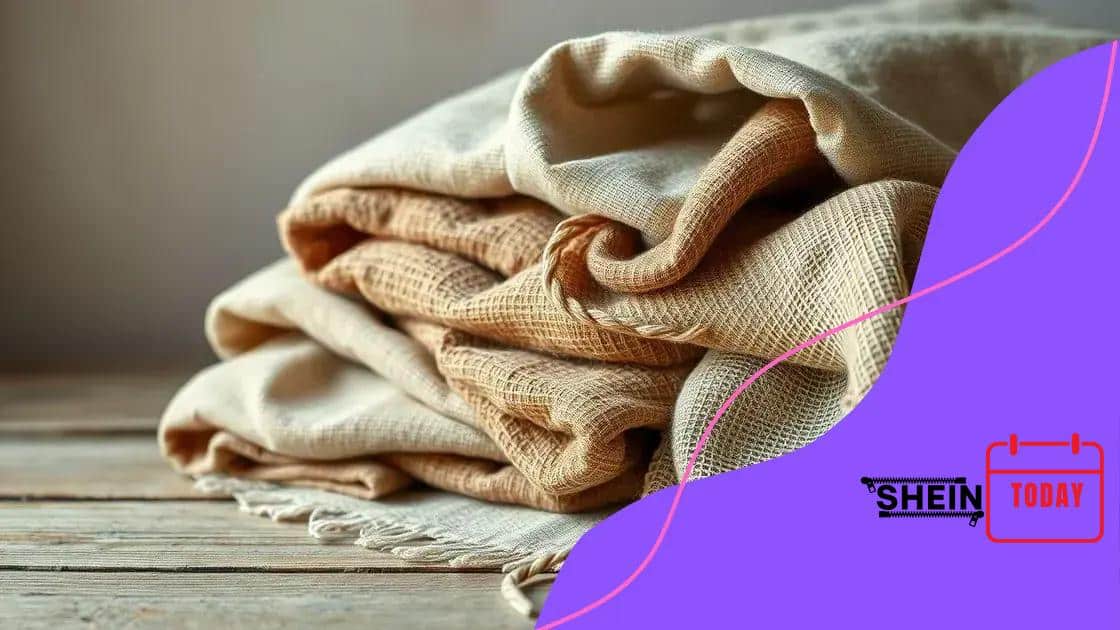Shein’s sustainable materials in fashion: a closer look

Shein’s sustainable materials in fashion focus on using eco-friendly fabrics like organic cotton and recycled polyester, while implementing innovative practices and consumer engagement to reduce environmental impact.
Shein’s sustainable materials in fashion are shaking up the industry as the fast fashion giant pivots toward eco-friendliness. Have you ever wondered how this company incorporates sustainability into its vast product line? Let’s dive in!
Understanding Shein’s commitment to sustainability
Understanding Shein’s commitment to sustainability is essential as the brand takes significant steps toward a greener future. This commitment involves a series of innovative practices that aim to reduce its environmental impact while still delivering trendy fashion to consumers.
Innovative Practices in Sustainability
Shein has initiated various programs to improve sustainability in its operations.
- Use of recycled materials in new collections.
- Resource-efficient production processes that minimize waste.
- Improved supply chain transparency.
- Investment in sustainable technologies.
Furthermore, Shein is striving to use more eco-friendly fabrics. This means exploring materials made from organic, recycled, and sustainable sources. For instance, they are looking into how cotton can be produced using less water and fewer chemicals.
Consumer Awareness and Involvement
As Shein embraces these changes, they also engage their customers. Providing information on sustainability helps empower shoppers to make informed choices. This initiative encourages dialogue about the impact of fashion on our planet.
They even hold events and campaigns promoting sustainability, where customers can learn how their choices influence the environment. Just imagine the impact if more fashion brands followed Shein’s lead!
In the long run, Shein’s proactive approach can reshape the industry standards, encouraging other companies to adopt similar practices. The journey towards sustainability is just beginning, and brands like Shein are stepping up.
With ongoing efforts and a focus on eco-conscious strategies, Shein’s commitment to sustainability proves that fashion does not have to come at the expense of the planet.
Exploring the range of sustainable materials used
Exploring the range of sustainable materials used by Shein reveals a commitment to eco-friendly fashion. The brand adopts various innovative materials to minimize environmental impact while offering trendy options to its customers.
Types of Sustainable Materials
Shein utilizes a blend of traditional and modern fabrics that are more environmentally friendly.
- Organic Cotton: Grown without pesticides, this material is less harmful to the environment.
- Recycled Polyester: Made from recycled plastic bottles, this fabric reduces waste in landfills.
- Tencel: Produced from sustainably sourced wood, Tencel is biodegradable and requires less water.
- Hemp: A durable plant-based fabric that grows quickly and needs few resources.
These materials not only contribute to a greener fashion industry but also ensure quality and comfort. By choosing fabrics that are less resource-intensive, Shein demonstrates that fashion can be both stylish and sustainable.
Benefits of Using Sustainable Fabrics
The benefits of using sustainable fabrics extend beyond the environment. These materials often have unique characteristics that enhance consumer experience. For example, organic cotton is softer and hypoallergenic, making it perfect for sensitive skin. Additionally, recycled polyester helps reduce reliance on virgin plastic, promoting a circular economy.
Shein is also working on achieving certifications for these materials. Gaining certifications ensures transparency and builds trust with consumers. Knowing that their purchases support sustainable practices can motivate shoppers to choose eco-friendly options regularly.
In summary, Shein’s exploration of sustainable materials illustrates a significant step in reshaping the fashion industry. With various options available, consumers are given the power to make informed decisions and contribute to a healthier planet.
Impact of sustainable fashion on consumer choices

The impact of sustainable fashion on consumer choices is becoming increasingly significant as shoppers become more aware of their purchasing power. Many customers today seek brands that prioritize environmental responsibility and ethical practices.
Shifting Consumer Mindsets
Recent trends indicate a growing shift in consumer mindsets regarding fashion. Shoppers want to align their values with the brands they support. This awareness drives them to choose companies that are transparent about their sourcing and manufacturing processes.
- Transparency: Consumers prefer brands that reveal their production methods.
- Quality over Quantity: Many buyers now opt for fewer, higher-quality items instead of fast fashion.
- Eco-Friendly Practices: There is a strong preference for brands that use sustainable materials.
- Social Responsibility: Shoppers often support brands that promote fair labor practices.
This change in behavior impacts the strategies that brands like Shein adopt. By focusing on sustainable options, Shein can cater to this new consumer demand and differentiate itself in a competitive market.
Buying Decisions and Sustainability
Furthermore, sustainability has become an important factor in buying decisions. Many customers are willing to pay a premium for products that are environmentally friendly. This willingness opens up a whole new segment in the market, allowing brands to innovate and connect with eco-conscious shoppers.
As information spreads through social media and word-of-mouth, awareness is rapidly increasing. Shoppers often share experiences regarding sustainable purchases, fostering a community focused on responsible consumption. This community encourages more consumers to consider the environmental impact of their choices.
In summary, the impact of sustainable fashion on consumer choices is profound. The emerging consumer preference for sustainability not only influences purchasing patterns but also drives brands like Shein to evolve and adapt their practices accordingly.
How Shein measures the effectiveness of their practices
How Shein measures the effectiveness of their practices is a crucial part of their sustainability journey. The brand implements various metrics and feedback systems to evaluate their impact on the environment and the fashion industry.
Key Performance Indicators (KPIs)
Shein identifies several key performance indicators (KPIs) to assess their sustainability initiatives. These KPIs include:
- Reduction in Carbon Footprint: Tracking greenhouse gas emissions during production.
- Materials Utilization: Monitoring the percentage of recycled or sustainable materials used in their products.
- Waste Management: Analyzing the amount of waste generated and how much is repurposed or recycled.
- Consumer Engagement: Measuring customer awareness and appreciation of sustainable products.
Each of these indicators offers insights into how effectively Shein is implementing sustainable practices. By keeping a pulse on these metrics, the brand can make informed decisions and improve its processes.
Feedback from Consumers and Stakeholders
In addition to KPIs, Shein relies on feedback from consumers and stakeholders. Surveys and product reviews help gauge public perception and satisfaction regarding their sustainable initiatives. This feedback loop is essential for understanding what customers value in sustainable fashion.
Furthermore, Shein collaborates with various environmental organizations to gain external insights. By partnering with experts, they can refine their practices and align with best industry standards.
Ultimately, Shein’s commitment to measuring effectiveness shows their dedication to accountability. The continuous assessment allows them to adjust their strategies, ensuring they remain on track toward a more sustainable future.
Future trends in sustainable fashion and Shein’s role
Future trends in sustainable fashion indicate an exciting evolution in how clothing is produced and consumed. As environmental awareness grows, consumers expect brands to adapt and innovate. One prominent player in this shift is Shein, as it strives to align with upcoming trends to meet customer demands.
Innovations in Material Usage
One major trend is the use of innovative materials. Brands are increasingly looking for alternatives to traditional fabrics. Shein is exploring options such as:
- Biodegradable Fabrics: These materials break down more easily, reducing environmental impact.
- Smart Textiles: Fabrics that monitor body temperature or provide other functionalities.
- Carbon-Neutral Options: Products that are manufactured with minimal carbon emissions.
- Recycled Materials: More brands are focusing on turning waste into new clothing.
By incorporating these materials, Shein can cater to the growing demand for sustainable products, showcasing its commitment to innovation.
Consumer-Centric Approaches
Another important aspect is the growing trend of consumer engagement. Fashion brands are shifting towards transparency and sustainability. Shein emphasizes understanding consumer preferences regarding sustainability, allowing customers to have a say in the products they wish to see. This shift builds loyalty and trust.
Sustainable fashion is also moving towards circularity. Brands are exploring ways to encourage recycling and reusability. Shein may adopt programs that incentivize customers to return garments for recycling, further reducing waste in the fashion industry.
Looking ahead, Shein’s role will likely focus on leading the sustainable practices in fast fashion. By anticipating trends and adapting to consumer needs, they can set a new standard for the industry. The future of sustainable fashion looks promising, and Shein is positioned to play a crucial role in this evolving landscape.
The fashion industry is changing, and Shein is at the forefront of this transformation. By embracing sustainable practices, Shein not only meets consumer demand but also sets a new standard in the fast fashion world. The brand’s commitment to using eco-friendly materials and improving production processes is essential for a more sustainable future. Consumers play a vital role in this journey, as their choices drive brands to innovate and prioritize the planet. Together, we can make fashion choices that support sustainability, benefiting both our wardrobes and the environment.
FAQ – Frequently Asked Questions about Shein’s Sustainability Practices
What sustainable materials does Shein use?
Shein uses a variety of eco-friendly materials such as organic cotton, recycled polyester, and biodegradable fabrics to reduce environmental impact.
How does Shein measure its sustainability efforts?
Shein tracks key performance indicators (KPIs) like carbon footprint reduction, the percentage of sustainable materials, and consumer engagement to measure the effectiveness of its practices.
Why is consumer feedback important for Shein?
Consumer feedback helps Shein understand customer preferences and improve its sustainability initiatives, ensuring that it meets the needs of eco-conscious shoppers.
What future trends in sustainable fashion is Shein focusing on?
Shein is focusing on innovations like using smart textiles, promoting circular fashion, and enhancing transparency in its production processes to align with future trends.





